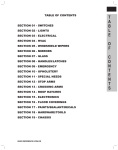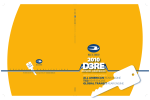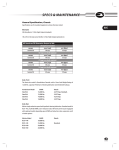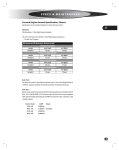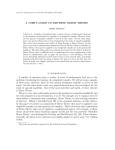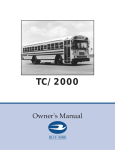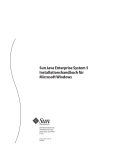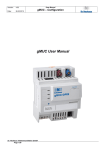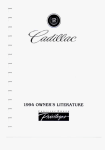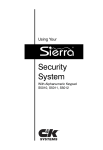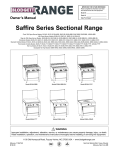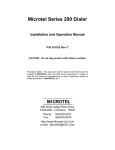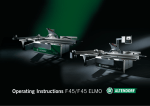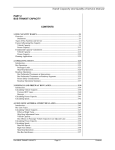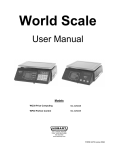Download BLUE BIRD MICRO BIRD - Central States Bus Sales, Inc.
Transcript
A1VC B1VC B2VC BLUE BIRD MICRO BIRD 8 17 04 0 10 2010 10004178 © 2006 Blue Bird Corporation. All rights reserved. All Blue Bird products sold for use in the United States of America and its insular areas comply with all applicable Federal Motor Vehicle Safety Standards (FMVSS) adn applicable Federal ADA requirements. Many of the components of Blue Bird buses are obtained from outside suppliers. Where maintenance and/or service information conflicts with the component manufacturer’s documentation, the manufacturer’s documentation prevails. In the event of any conflict between the requirements of this publication an dany applicable legal requirement, the legal requirement prevails. Technical requirements that exceed the legal requirements are not considered to conflict. Blue Bird Corporation continually endeavors to improve its products and reserves the right to change without notice. Text, illustrations, and specifications in this manual are based on information available at the time of printing. CONTENTS Foreword / 6 Before Placing the Bus in Service / 7 Reporting Safety Defects / 7 Body Identification / 7 Tire Inflation Pressure Decal / 8 About 2007 Emissions Standards / 8 Regarding Modifications / 9 Daily Inspection / 10 Quarterly Inspection / 11 Yearly Inspection / 12 Mirrors and Adjustment / 24 Interior Mirrors / 24 Exterior Mirrors / 24 Mirror Maintenance / 26 Outward Opening Entrance Door / 27 Maintenance Requirements / 27 Circuit Breakers / 27 Windows, Hinges, and Locks / 27 Lubrication / 27 Floor Covering / 28 Drain Holes / 28 Switch Panel / 13 Destination Signs / 28 Seats and Seat Belts / 14 Jacking & Towing / 28 Driver’s Seat Belt Operation / 14 Passenger Seat Belt Operation (If So Equipped) / 14 Seat Belt Inspection And Maintenance / 14 Seat Cushion Removal And Installation—dot Seat / 14 Removal / 14 Installation / 15 Seat Cushion Removal And Installation—dot Seat Belt Seats / 15 Removal / 15 Installation / 15 Child Restraints / 16 Young Children And Infants / 16 How Child Restraints Work / 16 Universal Child Restraint Anchorage / 16 Securing A Universal Child Restraint / 17 Normal Current Usage / 18 Standard Equipment / 18 Constant Load / 18 Intermittent Load / 18 Optional Equipment / 19 Policy / 19 Constant Load / 19 Intermittent Load / 20 Light Bulb Data / 21 Interior Lights / 21 Exterior Lights / 21 Wheelchair Lifts / 29 Stop Arms / 30 Maintenance / 30 Monthly / 30 Quarterly / 30 Stop Signs And Crossing Arm Troubleshooting / 31 Stop Sign Warning Light/Blade Failure / 32 Areas to Check: / 32 Emergency Equipment / 32 Fire Extinguisher / 32 First Aid Kit / 32 Body Fluid Cleanup Kit / 32 Fire Axe/crowbar / 33 Flare Kit / 33 Triangular Warning Devices / 33 Heaters / 34 Heater Operation / 34 Defrosting / 34 Heater Hose Clamp Service / 35 Heater Bleeding Instructions / 36 Glass Replacement / 38 Split Sash / 38 Rear Vision / 39 Entrance Door / 39 Emergency Exits / 40 Visibility Equipment / 22 3 Keeping Your Vehicle Looking New / 41 Washing Your Vehicle / 41 Polishing And Waxing Your Vehicle / 41 Foreign Material Deposits / 41 Finish Damage / 41 General Maintenance Schedules / 42 About Service Intervals / 42 Vendor-Supplied Maintenance Guidelines / 42 4 INTRODUCTION T hank you for selecting the Blue Bird Micro-Bird. This body/chassis combination is the result of developments in mass transportation which have been ongoing since 1927. The design and construction of the Micro-Bird bus body reflects Blue Bird’s concern for efficiency and— above all—safe operation. This manual has been prepared to acquaint you with various aspects of service, maintenance, and operation. It explains the various features and controls which should be familiar to you before you attempt to drive the unit. It will help keep your Blue Bird Micro-Bird in top operating condition and help extend its service life. Your Blue Bird Micro-Bird may not have all of the equipment described in this manual. Therefore, you may find maintenance data for equipment not installed on your bus. Please note that some sections of the manual are written for more than one product offered by Blue Bird, so some illustrations may differ slightly from what you find on your own bus. Text, illustrations, and specifications in this manual are based on information available at the time of printing. We reserve the right to make changes at any time without notice. You are encouraged to contact your Blue Bird distributor if additional maintenance information or assistance is needed. For chassis-related service and maintenance information, contact your local chassis distributor or representative. The complete line of Blue Bird Service Parts is available from your Blue Bird distributor. The use of original Blue Bird replacement parts and components will help ensure that your Micro-Bird remains true to its original design, best preserving our high standards of performance, efficiency, and safety. Proper operation, service, and maintenance are important to the safety and reliability of all motor vehicles. The information contained herein is provided as a reference for systems and components that require periodic service. The intervals given are manufacturer’s recommendations and should be considered maximum intervals. Actual operating conditions must be considered and maintenance intervals adjusted accordingly. Any time a system does not perform satisfactorily, corrective service should be performed at once. The Micro-Bird is larger than a typical automobile. Acceleration will likely be slower than that of a car or truck. You may find that steering, brakes, and other systems feel different from what is familiar to you. This makes it very important, from a safety standpoint, for you to become completely familiar with bus operation before attempting passenger transit. [CAUTION] No one should attempt to operate this coach without (1) thorough knowledge of all instruments and controls, (2) supervision, or actual driving experience in this or a similar vehicle under supervision, and (3) an appropriate license or permit to operate. Do not drive the coach until the space in front, on the sides, and in the rear is unobstructed. Most accidents occur because the operator did not ensure a clear path before driving. The operator should read this manual, as well as the manual supplied by the chassis manufacturer, before attempting to drive the unit. This manual provides you with the most current maintenance and operation information available. We welcome your comments and suggestions regarding this manual. Please direct all correspondence to: Blue Bird Body Company Attn: TECHNICAL PUBLICATIONS P.O. Box 937 Fort Valley, GA 31030 5 MICROBIRD Foreword This Operator’s Manual provides some general and specific information regarding safe operation and maintenance of your Blue Bird bus. It does not address all items or situations that may arise, and it is not a substitute for proper driver and mechanic training. Exercise of care, common sense, good driving and working practices are required for safe operation. If this manual does not adequately address your specific questions or concerns, please contact your Blue Bird distributor. The distributor will answer your questions or put you in contact with the proper factory personnel. Throughout this manual are precautions labeled Warnings and Cautions, and set in the style shown here: [WARNING] The Warning designation is generally used for precautions which, if not properly observed while performing the related procedures or handling materials, could result in serious personal injury or death. [CAUTION] The Caution designation is generally used for precautions which, if not properly observed while performing the related procedures or handling materials, could result in damage to the bus or its equipment. Blue Bird Corporation offers standard and optional equipment to meet federal, state, and local specifications and individual customer requirements. Properly selected equipment can help ensure reliable and safe transportation of passengers. Examples of this safety equipment include: stop arms, crossing guards, warning lights, warning light monitors, mirrors, first aid kits, fire extinguishers, warning reflectors, flares, directional and brake lights, warning buzzers, security locks, emergency exits, and seat belts. It is the driver’s responsibility to ensure that the safety items are in proper order. Equipment relating to safety should be checked for operation on a daily basis. Safety equipment may vary due to federal and state specifications, and individual customer requirements. In addition, the driver/operator must ensure that the loading area around the bus is clear of pedestrians before stopping, and that all unloaded passengers are a safe distance away from the bus before moving. You should also have received an operator’s manual from the chassis manufacturer with your vehicle. If you failed to receive such a manual, contact the chassis manufacturer’s closest dealership immediately to obtain one. Please read this manual and the chassis manual carefully before operating or repairing your bus. 6 dri v ers h a nd b oo k Before Placing the Bus in Service It is the responsibility of the bus Owner/Operator to ensure compliance with all federal, state, and local regulations for school bus operation and equipment. As part of a daily pre-trip inspection, the Driver should consider it his/her responsibility to verify that the vehicle is in satisfactory working order and that all emergency equipment is in place, fully stocked (First Aid Kit), up-to-date (Fire Extinguisher), and in proper working condition. Inspection guidelines from individual state inspection manuals (such as Commercial Driver’s License pre-trip inspection procedures) take precedence over those found in this manual. Guidelines found herein are in addition to those in your state’s inspection requirements. l [WARNING] Emergency equipment must be checked for proper operation daily. It is the Driver’s responsibility to report any damage to qualified Service Technicians and to ensure that the condition is corrected before transporting passengers. The Driver is responsible for determining that the loading area is clear before stopping to load passengers. The Driver must ensure that all unloaded passengers are clear before moving the bus. Reporting Safety Defects If you believe that your vehicle has a defect which could cause a crash or could cause injury or death, you should immediately informthe National Highway Traffic Safety Administration (NHTSA) in addition to notifying Blue Bird. If NHTSA receives similar complaints, it may open an investigation and, if it finds that a safety defect exists in a group of vehicles, it may order a recall and remedy campaign. However, NHTSA cannot become involved in individual problems between you, your dealer, or Blue Bird Corporation. To contact NHTSA, you may call the Vehicle Safety Hotline toll-free at: 1–888–327–4236 (TTY: 1–800–424–9153) or go to: http://www.safercar.gov or write to: Administrator, NHTSA, 400 Seventh Street, SW., Washington, DC 20590 Body Identification Plate You can also obtain other information about motor vehicle safety from: http://www.safercar.gov. Body Identification The Body Identification Plate is located above the right side of the windshield. Refer to this plate for registration purposes or for replacement part information. Vehicle Certification Plate The Vehicle Certification Plate certifies that the vehicle conforms to all applicable Federal Motor Vehicle Safety Standards in effect at the date of manufacture. Do not remove or deface this plate. This plate is located over the driver’s window. 7 MICROBIRD Tire Inflation Pressure Decal A decal specifying tire inflation pressures is attached to the door frame post of the Driver's entrance door just below the door latch. Also refer to the chassis Operators Manual for recommended cold inflation pressure according to specific loads, speeds, and applicaitons. [WARNING] Tire inflation pressure must not exceed the specifications of the tire and/or wheel rim manufacturer for the application. The inflation pressure embossed on the tire sidewall does not take the wheel or rim capacities into consideration. Tires should not be inflated above the pressure listed on the Federal Certification plate without consulting your tire/wheel distributor. About 2007 Emissions Standards Buses equipped with 2007 diesel engines are designed to conform to new and stringent federal emissions standards. These standards affect both the equipment installed at the factory and the fuel at the pump. Buses powered by 2007 emissions standards diesel engines are equipped with special exhaust systems to reduce emissions. The technical details of the systems employed by various engine manufacturers differ, but share common general principles. The exhaust muffler is a particulate filter which traps and burns microscopic particles in a process referred to as “regeneration.” When heat in the exhaust is insufficient to fully burn the particulates, the system enters an “active” regeneration mode so the necessary catalytic reaction can take place. During active regeneration events, exhaust temperatures are elevated, and an indicator light on the instrument panel illuminates to notify the Driver that regeneration is active. This regeneration mode is automatic and normal, and requires no special action on the part of the Driver. As part of the 2007 emissions standards, effective October 15, 2006, the EPA has required fuel retailers to sell lower-emission fuel, designated “ultra-low-sulfer diesel”. After that date, all commercially-available number 1 and number 2 highway diesel fuels are Ultra-low-sulfer diesel. This fuel must be used in all 2008 model buses powered by a 2007 emission standards diesel engine, as indicated by a decal located near the fuel filler door, reading: The engine in Blue Bird buses equipped with diesel engines must be operated only with low ash engine oil and ultra low sulfur diesel fuel (meeting EPA specifications for highway diesel fuel, including a 15 ppm sulfur cap). For detailed information on recommended fuels and other fluids, always follow your engine manufacturer’s guidlines. 8 dri v ers h a nd b oo k l Regarding Modifications Blue Bird Corporation offers many items as standard and optional equipment to meet federal, state, and local specifications and individual customer requirements. Those interested in modification of thisvehicle should consult the Service Manual and Blue Bird Engineering Department for a more complete understanding of the vehicle. Vehicle modifications which may cause non-conformance with the emission control and/or Federal Motor Vehicle Safety Standards ((FMVSS), are expressly not authorized by Blue Bird Corporation. It is the responsibility of the entity undertaking the modification to ascertain compliance of the modified vehicle with any and all applicable regulations. The entity performing modification of this product must certify that all applicable regulations are met. In order to certify a modified vehicle, the upfitter or other entity performing the modification must be a licensed vehicle manufacturer or must objtain the services of a licensed vehicle manufacturer for that purpose. Specifically, Blue Bird Corporation does not authorize any modifications to or such as the following: • Front or rear suspension • Wheelbase length • Body or chassis crossmembers • Frame rail flanges • Welding on the engine, radiator, fuel tank(s), transmission or any component of those items • Cooling system • Addition of any equipment or component nearer than 2 inches (51mm) to the fuel tank(s), rotating components or “jounce” movement of driveline components 9 MICROBIRD Inspection Daily Inspection To keep your bus in the best operating condition in terms of safety, convenience, service, and operating expense, follow these recommended inspection procedures on a daily basis, as well as all inspection procedures recommended by your chassis manufacturer. Any malfunctions or defects should be corrected before the next trip. Report needed services to responsible maintenance personnel. Outside the bus: • Wipe clean the windshield, mirrors, front windows, headlights, taillights, directional lights, and stop lights. • Ensure the tailpipe is clear. • Check tire pressure and treads. Ensure the lug nuts are in place. • Ensure the area under the bus is all clear. • Check the general outside appearance. Ensure there is a clear view of identifying features (license plate, school/organization name, bus number, etc.) • Ensure the mirrors are clean and adjusted. Inside the bus: • Ensure the seats and floor are clean. Ensure the steps and aisle are clear. • Verify that the emergency exits, rear door, and windows can all open and close. • Check emergency equipment and first aid kit. • Check pressure on fire extinguisher. • Ensure the windshield and windows around the driver’s area are clean. • Ensure the mirrors are clean and adjusted. Starting the engine: • Be sure parking brakes are on. • Put in Neutral. • With key on, check fuel gauge. Check brake warning buzzer or light, neutral safety switch. • Start engine. Look and listen for trouble signs; check gauges. With the engine running, check (from driver’s seat): • Mirrors, interior and stepwell lights, service door seal. • Check the steering feel. Check for any unusual noise. 10 dri v ers h a nd b oo k l • Ensure the horn, defroster/heater blower, and windshield wipers are working properly. • Check the brake pedal for right height and feel. Check the gauge reading. Check the Parking brake release, reset. Outside checks required before driving away: • Check right- and left-turn signals in front and rear. Ensure they are clean and flashing. • Ensure the flasher warning lights in front and rear are clean and flashing. • Ensure the stop arm is clean and working. • Check hi-lo beams in headlights. • Ensure stop lights and taillights are clean and working. • Ensure hazard flasher is working. Final check while moving the bus: • Ensure the seat belt is fastened. • Ensure the brakes stop and hold. • Ensure the steering feels OK and there are no unusual noises. • Ensure bus is under control and tracking straight. • Brake to a stop. Check gauges. Remember: Safety on the road depends on you. Observe weather and road conditions and drive accordingly. Be physically and mentally alert. When backing up near pedestrians or in congested areas, use outside monitor or director. Look around before driving away from where you are parked and observe all traffic rules and regulations. Quarterly Inspection • Inspect fire extinguisher to see if it is fully charged. • Check first aid kits to see if it is fully equipped. • Oil all hinges and window latches for ease of operation. • Lubricate all window channels with silicone or graphite. • There is one drain hole in each floor section under windows. Be sure hole is clear of debris so any water may escape. • Clean all rubber door seals and lubricate with rubber lubricant. 11 MICROBIRD • Lubricate all rear and side emergency door latch slide bars with light grease to reduce friction. • Tighten all body tie-down bolts to between 75–85 ft lbs (102–115 Nm) torque at 1,500 kilometers, and quarterly thereafter. • Grease emergency door hinges. Yearly Inspection • Complete Quarterly Inspection. • Remove all seat cushions, thoroughly clean with upholstery cleaner, and reinstall on a rotating basis. • Adjust door control rod and closing mechanism to entrance doors. • Thoroughly clean all front heater cores. • Bleed all air from heaters. • Tighten all heater hose clamps. • Wash underseat heater core filter(s). These checklists are suggested. They do not replace or supersede local or state required driver inspection procedures. 12 dri v ers h a nd b oo k l Switch Panel 1. Left rearview mirror control. 2. Right rearview mirror control. 3. Electric door control. (If so equipped) 4. Manual warning light switch. 5. Master warning light switch. Systems may vary on some units. 6. Warning light switch emergency override. 7. Clearance lamps. 8. Dome lights. 9. Underseat heater. 10. Heater pump. 11. Mirror defrost. 12. Auxiliary fan. 13. Strobe Light. 14. Destination sign. 15. Lift. 16. Stop arm/crossing arm. 17. Auxiliary switch/switch panel rheostat. 18. Emergency exit or lift pilot light. 19. Pilot—shows amber warning lights are flashing. 20. Pilot—shows red warning lights are flashing. 21. Pilot—warning light monitor. For Positions 7-17, the components are located in order of dominance, depending on unit equipped features. Driver’s compartment is not indicated. It is located above driver’s side door, accessible by depressing the release button latches. The function of the Heater Master Switch (if so equipped) is to turn off all heaters and the radio to allow the driver to hear sounds outside the bus, such as when the bus is at a railroad crossing. When switch is in the up position, heaters and radio will deactivate. When switch is in the down position (see illustration), these devices will function as normal. 13 MICROBIRD Seats and Seat Belts Driver’s Seat Belt Operation For driver’s seat belt operation, refer to chassis manual. If you failed to receive such a manual, contact the chassis manufacturer’s closest dealership immediately to obtain one. Passenger Seat Belt Operation (If So Equipped) Individual lap belts for passengers are retractable or non-retractable, depending on option ordered. Insert the catch into the buckle, test for assurance of latch fit, and pull loose end of strap until belt fits snugly across the lower hips. The buckle can be released by pushing the button in its center. The adjustable end can be moved outward on its strap by turning 90° to the strap and pulling. Seat Belt Inspection And Maintenance Inspect seat belts and their attachments on a weekly basis. Check seat belt buckles and adjustability to ensure proper operation. If necessary, lubricate buckle with a graphite lubricant. When buckle is found to be inoperable, replace immediately. If there are any defects in the webbing (i.e., torn or frayed), the seat belt must be replaced immediately to ensure passenger safety. Hand-wash webbing with warm water and mild soap. Rinse thoroughly and dry in the shade. Do not bleach or redye, because such processing may severely weaken the assembly. [WARNING] Be sure the lap belt is fitted snugly across the hips, and not the waist. Failure to do so may increase the chance of injury in the event of a collision. [WARNING] If seat cushions are removed for maintenance, they must be installed using the following instructions. Failure to comply with these instructions could result in injury from unattached seat cushions in the event of an accident. Seat Cushion Removal And Installation—dot Seat Removal 1. Loosen the two front swivel type clamps at the front underside of the cushion with a Phillips-head screwdriver. Do not remove clamps. 2. Rotate the swivel clamps in order to clear the front retaining channel frame. 3. Lift the forward edge of the cushion five to eight centimeters and pull cushion forward to remove. 14 dri v ers h a nd b oo k l Installation 1. Place the rear edge of the cushion down on the base portion of the seat frame. Lifting the forward edge of the cushion five to eight centimeters, slide the cushion to the rear to engage the positive type clamp into the rear retaining channel. 2. Lower the forward edge to the frame, making sure the swivel clamps are inside the frame and the positive type clamps are secure on the rear retaining channel. 3. Rotate the swivel clamp to engage the forward retaining channel frame. 4. Tighten with Phillips-head screwdriver until clamps do not rotate. Seat Cushion Removal And Installation—dot Seat Belt Seats Removal 1. Loosen the two front swivel type clamps at the front underside of the cushion with a Phillips-head screwdriver. Do not remove clamps. 2. Rotate the swivel clamp located at the rear underside of the seat cushion. 3. While lifting at the rear edge of the cushion, pull the cushion to the rear and remove. Installation 1. Place the forward edge of the cushion five centimeters to the rear of the front retaining clamps. Slide the cushion forward engaging the positive clamps onto the forward retaining channel. 2. Lower the rear edge of the frame and rotate the swivel clamps so they engage the square tube crossmember. 3. Tighten with Phillips-head screwdriver until clamps do not rotate. 15 MICROBIRD Child Restraints Young Children And Infants Everyone in a vehicle needs protection. This includes infants and all other children. Neither the distance traveled nor the age and size of the traveler changes the need for everyone to use safety restraints. In fact, the law in every state in the United States and in every Canadian province says children up to a certain age must be restrained while in a vehicle. Every time infants and young children ride in vehicles, they should have the protection provided by the appropriate restraint. Restraints must meet all applicable federal motor vehicle safety standards. [WARNING] People should never hold a baby or young child in their arms while riding in a vehicle. During a crash a baby will become too heavy to hold. For example, in a crash at only 25 mph, a 12 lb. baby will suddenly become a 240 lb. force on a person’s arms. A baby should always be secured in an infant restraint. Young children must be secured in appropriate child restraints. How Child Restraints Work A child restraint system is any device designed for use in a motor vehicle to restrain, seat, or position children. A built-in child restraint system is a permanent part of the vehicle. An add-on child restraint system is a portable one that must be installed. For years, add-on child restraints have used the adult belt system in the vehicle. To help reduce the chance for injury, the child must be secured within the restraint. The vehicle’s belt system secures the add-on child restraint, and the add-on child restraint’s harness system holds the child in place within the restraint. When securing an add-on child restraint, refer to the instructions that come with the restraint. These instructions may be labeled on the restraint itself or in a booklet, or both. Universal Child Restraint Anchorage Seats in this bus equipped with the universal child restraint anchors are identified by a decal located over the seat above the window. (See Decal illustration on the following page.) This vehicle may be equipped with a universal child restraint anchorage system. If so, you’ll find two anchors in the front lower seatback where the bottom of the seatback meets the back of the seat cushion and a third anchor in the lower rear seatback. (See the Universal Child Restraint Anchorage illustration.) In order to use this system, you need either a forward-facing child restraint that has attaching points (A) at its base and a top tether anchor (B), or a rear-facing child restraint that has attaching points (A) as shown. 16 dri v ers h a nd b oo k l Whenever applicable, use the universal child restraint anchorage system instead of the vehicle’s safety belts to secure a child restraint. [WARNING] If a child restraint isn’t attached to its anchorage points, the restraint won’t be able to protect a child sitting there. In a crash, the child could be seriously injured or killed. Make sure that the child restraint is properly installed using the anchorage points. Securing A Universal Child Restraint 1. Find the anchors (A) for the seating position you wish to use, where the bottom of the seatback meets the back of the seat cushion. See Universal Child Restraint Anchorage illustration. 2. Put the child restraint on the seat. 3. Attach the anchor points on the child restraint to the anchors in the bus seat. The child restraint instructions will show you how. 4. Attach the top strap to the top strap anchor (B). Tighten the top strap according to the child restraint instructions. 5. Push and pull the child restraint in different directions to ensure it is secure. 17 MICROBIRD Normal Current Usage Standard Equipment Constant Load Item Number Current (amps) Cluster Lamps 6 4.14 Clearance Lamps 4 2.76 Intermediate Side Marker 2 1.38 Tail Lamp* 2 1.18 Ignition 1 2.50 Instrument Panel 1.00 Headlamps 2 8.40 Parking Lamps 2 1.18 90-FC & MB Heater** 1 27.00 90-Conv. Heater** 1 31.50 Number Current (amps) Stepwell 1 0.44 Stop Lamp* 2 4.20 Varies 0.58 ea. Back-up Lamps 2 4.20 Electric Wipers 2 8.00 (Dual Low Beam) Intermittent Load Item Dome Lamps (each) 18 * Combined Stop and Tail Lamp ** Use Applicable Heater dri v ers h a nd b oo k l Optional Equipment To figure current draw, add constant load and 35% of intermittent load. Policy • Warning light options include lights, standard flasher, and pilot light. If optional flasher unit is desired, add current draw of that option. • Directional light options include lights and standard thermal flasher. Constant Load Item Auxiliary Fan Feature No. Current (amps) 3026-01 3.00 0531 6.00 0532, 0546 3.00 Heater 1145 31.5 1154 9.00 1230 2.50 1325, 1330 4.50 1336, 1342 9.00 Heater Pump 1416 6.75 Clearance Light 1576 2.16 1581 1.08 1591 0.54 Cluster Light 1642 1.62 Door Light 1878-01 0.59 1878-02 1.18 1878-03 1.77 3050, 3052, 3053 4.06 Destination Sign (Roll) 6165 4.06 School Bus Sign 3064 4.06 Front & Rear School Bus Sign3065 8.12 Destination Sign 19 MICROBIRD Intermittent Load Item Directional Lights Option Number 1686, 1697, 1701, 1719, 1723, 1727, 1731 1740 1790, 1788 1820 2.10 0.27 4.20 0.27 Dome Lights (**Per Lamp) 1825, 1828, 1831**, 1832**, 1840 0.58 7" Stop Lights 6723 1940, 6728 4.79 4.20 Warning Lights 1987, 1990, 1992, 2013, 2016, 2017 12.50 Solenoid Switch 2130, 2131 0.75 3000 0.50 3002-01 3002-02 3002-03 1.00 1.50 2.00 Buzzer (Emerg. Door) 3005 0.50 Emergncy Door 3020 0.94 Pilot Light & Buzzer 3025 0.94 Chime System 3040 1.00 3135, 3143, 3146, 3155, 3148, 3162 1.80 3159, 3149 3.60 3343 0.50 4015, 4475 1.50 56" Wheelchair Lift 0467 48.00 35" Wheelchair Lift 0469 48.00 42" Wheelchair Lift 0465, 0466 90.00 Buzzer (Emergency Door) Dot Buzzer Stop Arm w/Lights Stop Arms Dual w/Lights Pushout Windows w/Buzzer Sanders 20 Current (amps) dri v ers h a nd b oo k l Light Bulb Data Lamp Trade Name Trade Number Bulb Color Number Interior Lights Dome Weldon 8005 (Standard) 89 Weldon 8010 (Deluxe) 93 Stepwell Arrow 35 67 Emerg. Door Light Weldon 8025 67 Switch Panel Pilots Cole Hersee PL19 53 41204-1211 68 2007367 53 Dial Switch Panel Illuminator Exterior Lights Directional KD 772-9105 1156 Weldon 1010 Series Red & Amber Plain & w/Arrow 1156 Signal Stat 1604 1156 Warning Light Weldon 1020 Series Red & Amber 4636 Cluster & Marker Weldon Peterson 5050 122 Amber & Red Amber & Red 904 194 Side Directional Peterson 122 194 059-9900021CP 1073 Dominion Signal Stat 70-6128-71 2103 1157 1157 KD Weldon 854-5301 7-1010-1 1156 1156 1010 Red 438 1605 772-9105 1156 1157 1156 1156 Stop/Tail/Tag Back-Up Stop Arrow Weldon Arrow Signal Stat KD 21 MICROBIRD Visibility Equipment Required by Federal Motor Vehicle Safety Standards (FMVSS) 22 dri v ers h a nd b oo k l 23 MICROBIRD Mirrors and Adjustment Left and right front fender mounted convex crossview and left and right front fendermounted convex rearview mirrors are required equipment on all Micro-Bird buses. [WARNING] The vehicle’s mirror system has been designed to comply with all field-of-view requirements, but it is the owner’s responsibility to adjust the mirrors properly before placing the vehicle in service and to maintain the adjustment during the service life of the vehicle. Mirrors provide additional driver visibility on buses. To be used effectively, mirrors must be properly adjusted for each driver and the driver must be aware of the limitations on viewing area that exist even when mirrors are properly used. Mirrors are not a substitute for proper driver training and care that should be exercised when operating the vehicle and loading or unloading passengers. Do not move the bus until you have accounted for each passenger that has disembarked and have confirmed that all passengers are clear of the bus. Failure to follow these procedures could cause serious injury or death. Interior Mirrors Inside rearview mirrors can be adjusted by loosening the bolts and nuts in slotted holes. Adjust the mirror to give the operator a clear view of the bus interior and the roadway to the rear. [WARNING] Many school bus passengers are energetic children who are small and playful and do not understand the hazards of buses. After unloading, some children could be outside the field of vision of your mirrors or could dart out of view quickly. After unloading passengers, do not move the bus until you have confirmed the location of each disembarked passenger, and know that all are completely clear of the bus. Failure to follow this procedure could cause serious injury or death. Exterior Mirrors Standard equipment on all school buses includes four outside rearview driving mirrors (two per side), and two elliptical crossview mirrors (one per side). The outside rearview driving mirrors include one flat and one convex on each side. The outside rearview driving mirrors are designed to provide the seated driver a view of the roadway to the rear and to the sides of the bus. The elliptical crossview mirrors are designed to allow a seated driver to view all areas around the front of the bus not directly visible. The elliptical crossview mirrors are designed to be used to view pedestrians while bus is stopped. Do not use the elliptical crossview mirrors to view traffic while bus is moving. Images in such mirrors do not accurately show another vehicle’s location. 24 dri v ers h a nd b oo k l [CAUTION] A convex mirror has a curved surface and is designed to provide a wide view with minimum distortion. However, persons or objects seen in a convex mirror will look smaller and appear farther away than when seen in a flat mirror or viewed directly. Therefore, use care when judging the size or distance of a person or object seen in a convex mirror. Wait until you can view the person or object directly or in a flat mirror to determine his/her size and distance. Proper adjustment is necessary for any mirror system to perform as designed. The following adjustment sequence should be used to allow the driver to obtain the maximum viewing area with the mirror system. 1. Adjust the driver’s seat to the desired position. 2. Adjust the right-side flat driving mirror so that the tops of the side windows are visible in the upper edge of the mirror, and so that the right side of the bus body is visible in the inside edge of the right-side flat mirror. 3. Adjust the right-side convex driving mirror so that the view in the top of the convex mirror overlaps the view provided by the right-side flat driving mirror, and so that the right side of the bus body is visible in the inside edge of the right-side convex mirror. 4. Adjust the left-side flat driving mirror and the left-side convex driving mirror following the same procedures described for the right-side mirrors. Refer to Steps 2 and 3 above. 5. Adjust the elliptical crossview mirrors by positioning each mirror head so that the center of its field of view is pointed directly at the eyes of the seated driver. 6. Make a final adjustment to the mirror system so that the seated driver can view the areas required by Federal Motor Vehicle Safety Standard 111, including the entire top surface of cylinders M and N when located as illustrated on the following page, and rearward a minimum of 200 feet (measured from the mirror surface) using the outside rearview driving mirrors. The elliptical crossview mirrors should be adjusted to provide the seated driver a view of the entire surface of any cylinder A thru P (when located as illustrated) not visible by direct view of the driver. The view provided by the elliptical crossview mirrors must overlap the view provided by the outside rearview driving mirror system. 25 MICROBIRD Mirror Maintenance All mirrors should be cleaned once a week (or more if needed), preferably with an ammonia solution. Keep the mounting fasteners tight so that mirrors will not vibrate. Check weekly and retighten, if necessary. 26 dri v ers h a nd b oo k l Outward Opening Entrance Door The entrance door is mounted in a prefabricated framework which eliminates effect of body construction variations on door and seal operation. Doors are suspended completely on sealed ball bearings located at the top corners of the framework, inside the body. The interlink connection between the doors is a single assembly with oppositely threaded spherical bearing rod end connectors on each end providing simple link length adjustment without disassembly. Simply loosen the lock nut, turn the tube, and retighten the nut when satisfactorily adjusted. The geometry of the mechanical link between the doors causes the rear door to close well ahead of the front door, so that the front nosing seal rubber always overlaps the rear. Oilimpregnated bronze bearings in the lower corners of the framework serve as pivots (not supports). All controls and mechanisms and the complete lower step tread are sealed inside the bus and out of the weather when the door is closed. A 10-cm-wide pad is mounted to the header cover over the opening. The manual control is an over-center locking type with a built-in SafLatch. The door’s ease of operation allows use of a short handle arm. Maintenance Requirements 1. Keep working parts of control tightened. 2. Lubricate all working parts periodically, including hinges and overhead controls (see Body Component Maintenance Chart). 3. Repair or replace worn seals. 4. Maintain proper door opening and closing adjustment (see Body Component Maintenance Chart). Circuit Breakers Blue Bird uses circuit breakers and fuses. The circuit breakers are a quick resetting type and are located behind the driver’s compartment above the driver’s side door. The advantage of circuit breakers is that no replacement (as with fuses) is required. When the breaker opens a circuit, follow standard electrical troubleshooting procedures within the circuit to determine the cause of overload. Exposed wires and electrical shorts are the most common causes. To access circuit breakers and fuses, remove the rear panel of the driver’s compartment. Windows, Hinges, and Locks Lubrication 1. Lubricate latches and sliding seal of top window with silicone every thirty days. 2. All exterior hinges should be lubricated every thirty days with a light weight oil. 27 MICROBIRD 3. Inside hinges and door control hardware should be lubricated quarterly with a light weight oil. 4. A heavy grease should be used on the upper door control quarterly. 5. Luggage compartment latches should be lubricated every thirty days with a silicone type grease. 6. Luggage compartment lock cylinders should be lubricated with a graphite lubricant every thirty days. 7. Lubricate the positive hold open hinge on the rear emergency door with the door closed, using a low temp grease per ASTM 4950 GC-LB Grade 2 -60° to 350° F monthly. (If so equipped) 8. A heavy grease should be used on the emergency door hinges quarterly. Floor Covering The floor covering should be swept daily, if at all possible, to avoid dirt from being ground into the covering. Do not use sweeping compounds as this may cause a deterioration of the covering. Do not allow substances such as road salt to build up. When mopping, use a mild detergent with water. Do not use solvent-type cleaners. Mop and rinse with a damp mop only, not with a water hose. Excess water may cause the covering to separate from the plywood sub-floor. If separation does occur and “bubbles” appear, cut the material to gain access to the underside. Clean the underside of the covering and sub-floor where separated and re-bond with a high-quality contact cement. Drain Holes There are two drain holes located in each floor section; one right hand side under window, and one left hand side under window. These holes should be cleared of all debris quarterly to allow for water drainage. Destination Signs Two Station Sign—Rear lighted, sign material masonite with lettering on both sides. Lubricate interior door hinge. Jacking & Towing See the manual provided by the chassis manufacturer for proper jacking instructions, procedures, and locations for jack placement. [WARNING] Do not lift the vehicle by the bumper. Bumpers are designed to protect the vehicle and occupants during a collision, they are not designed for towing or jacking up the vehicle. Blue Bird does not recommend towing or jacking the vehicle by the bumpers. 28 dri v ers h a nd b oo k l Optional tow hooks are located at the front and/or rear of the vehicle under the bumper. Tow hooks are designed to tow or pull with both hooks simultaneously. [CAUTION] Do not pull or tow with an individual hook. Blue Bird does not recommend towing or jacking the vehicle by the bumpers. [WARNING] The tow hooks are designed for horizontal pulling only; not for lifting. Never attempt to lift the bus by the tow hooks. Wheelchair Lifts Blue Bird Micro Bird buses may be fitted with lifting platforms designed to aid in loading and un-loading passengers. There are 2 optional wheelchair lifts available. The units available are: Ricon™ model S5010 and Braun™ model L919FIB. Both offer a maximum of 48 inches (122 cm) lift from the ground to the level of the bus floor. For the correct operation and maintenance of the wheelchair lift on your bus, please refer to the operator’s manual supplied by the OEM. [WARNING] Operators should familiarize themselves with the OEM operator’s manual prior to loading passengers on the lift. All lifts have maximum weight limits that should never be exceeded. These lifts are operated by an independent, electro-hydraulic, power system, and are controlled by the operator from outside the bus. There is a “master” or enable switch, located in the driver’s area that must be activated. You must first set the park brake before enabling the master switch. After closing the enable switch for the lift, the operator must access the lift from outside the bus. When the lift door is opened, you will find the control pendant for the lift. Although the decals on the control pendant clearly indicates the function of each switch on the panel, it is important that the operator be thoroughly familiar with the OEM Operator’s Manual and actual operation of the lift, prior to attempting passenger management. The bus electrical system powers a hydraulic pump, internal to the lift, which moves the lift up. The “down” function is gravity type and is controlled by pressure release valves. Manual operation of the “down” function requires that the operator manually control the pressure release valves. To provide for the manual “up” function, the lift is fitted with a hand operated hydraulic jack, located on the forward side (from inside the bus) side of the lift assembly. See the accompanying illustration for location of the manual, or “emergency” controls. The wheelchair lift, and the lift door, include electrical circuits that help to provide safe operation of the lift platform. An interlock system prevents the wheelchair lift from operating until the park brake is set. The lift light is energized by the bus interior lighting switch, the “dome light”. The dome light must be on for the lift light to illuminate. 29 MICROBIRD The warning buzzer for the lift door is designed to alert the driver when several conditions exist. • During normal operation (no lift function activated), the buzzer is silent. • When the locking bar on the lift door is not engaged, the buzzer sounds, alerting the driver that the door is ajar. The buzzer will sound continuously until the lift access door is opened fully. • As the lift door becomes completely opened and stowed, the buzzer will fall silent. After the lift is stowed and the lift door is being closed, the buzzer will sound until the door is completely closed and locked into position. The operator may then release the park brake and proceed in the normal manner. If the lift mechanism is inadvertently left deployed or in the stowed position with the lift door open, the buzzer will be silent. However, the interlock will prevent the park brake from being released. Stop Arms Stop arms are required on Blue Bird school buses by Federal Motor Vehicle Safety Standard 131. Stop arm assemblies are purchased as a kit; many different kits are available with blades to meet various state requirements. The stop arm is located on the driver’s side of the body just behind driver’s door. Stop arms are most commonly operated manually, using a switch on the switch panel. For electrically operated stop arms, the switch activates a control relay which, in turn, energizes movement of the stop arm. Optionally, this sequence may be activated by the warning lamp system. Maintenance The following preventive maintenance procedures should be followed for the electric stop arm: Monthly • Oil the dual-action breakaway hinge at four pivot points with a high-performance, penetrating, lubricant. Tri-Flow™ (DuPont) with Teflon™, or equivalent, is recommended. • Check to ensure the breakaway portion of hinge is free and movable. • Check all the fasteners for tightness. Quarterly • Remove front and rear covers of base and check internal fasteners for tightness. 30 dri v ers h a nd b oo k l The “STOP” sign must extend, and if so equipped, the lights must be operating while the red lights of the warning light system are flashing. For those state-designed warning light/stop arm systems that allow the stop arm to withdraw while warning lights are operating, an audible alarm sounds to alert the driver to this condition. Stop Signs And Crossing Arm Troubleshooting Electrically operated stop signs and crossing guards may be wired in either of 2 ways: 1. Dark blue to a switched 12 VDC terminal. Red to a “hot” 12 V terminal. Green to a chassis ground. In this configuration, the blue wire controls the stop sign. 2. Dark blue and red to a “hot” 12 VDC terminal. Green to a switched, grounding terminal. This configuration uses the green ground wire to control the stop signs and crossing arms. The motor and mechanism that moves an electrically operated stop sign or crossing arm is located in the base of the device. If one of these devices fails to operate as planned: 1. Determine if the sign is wired correctly (matches configuration 1 or 2 above). 2. Ensure that 12 VDC and ground are present where required. 3. Remove the rear cover of the base. 4. Remove both leads from the motor terminals. 5. Apply 12 VDC to the red terminal on the motor. 6. Ground the black terminal of the motor. The motor should run until one of the leads is removed. If it does not, the motor is bad. 7. Replace the wires to the motor. 8. Remove the red wire from the relay that goes to the motor. 9. Remove the red wire from the limit switch. 10. Place the red wire from the motor on the positive terminal of the limit switch. 11. Ground the motor terminal (the black lead). 12. Apply 12 VDC to either the black or light blue lead on the limit switch. If the motor does not run with the black lead connected to 12 VDC, apply 12 VDC to the light blue lead. If the motor fails to run in either configuration, the relay is bad. 13. If the motor runs, it should run until the CAM circles and opens the limit switch, causing the motor to stop. At that time, change the 12 VDC supply 31 MICROBIRD to the limit switch to the other lead; the motor should run until the CAM positions itself to deactivate the limit switch. If both these leads operate the motor, the limit switch, CAM, and motor assembly are functioning properly. Stop Sign Warning Light/Blade Failure Areas to Check: 1. Check that the light bulb is okay. Replace the bulb if necessary. 2. Check that the ground strap is secure. Clean and tighten if necessary. 3. Check that 12 VDC is being supplied to the light bulb socket. Repair if necessary. The red paint used on steel blades contains a pigment that tends to bleach over time. If a blade surface fades, it may be repainted or replaced. Replacement is usually best due to labor savings and cost efficiency. High quality aluminum reflective signs are available. There are decal kits available for them that extend the appearance and performance for a reasonable time. Aluminum signs are more expensive than steel signs. Emergency Equipment Each state or province has its own set of laws regarding emergency equipment. Your unit may have some or all of the items listed below. Because of variations in option packages, the placement of this equipment inside the bus may vary from one unit to another, but it is important for you to recognize and know the locations of all the emergency equipment on your bus. Furthermore, it is important for you to read all literature, labels, and any other written materials supplied by the equipment manufacturers. Be sure you familiarize yourself with all aspects of the emergency equipment before attempting to drive the bus. Fire Extinguisher The fire extinguisher is located in the right front corner of the bus body near the floor. Your unit may be equipped with a 1.1, 2.25, or 2.75-kg extinguisher. Check quarterly to make sure it is fully charged. First Aid Kit The first aid kit is mounted above the windshield on the right hand side of the bus body. Size and contents of first aid kits may vary because of different state specifications. The kit should be inspected quarterly or as required by local regulation to be sure that all contents comply with state specifications. Body Fluid Cleanup Kit The body fluid cleanup kit is designed to contain accidental spillage of biological matter, minimizing risk of exposure to potential health hazards. The contents of the 32 dri v ers h a nd b oo k l kit should be inspected every 30 days or as required by local regulation to be sure that all contents comply with state specifications. Fire Axe/crowbar Your bus may be equipped with a fire axe and/or crowbar. Every 30 days, inspect installation mounting fasteners to make sure they are tight. Check the fire axe and/or crowbar monthly to see that they are easily accessible and unobstructed. Flare Kit If your bus is equipped with a flare kit, check every 30 days, or as required by local regulations, to see that its contents are in place. Inspect mounting fasteners for flare kit box every 30 days to ensure that they are tight. Triangular Warning Devices Your unit may be supplied with triangular warning devices. Inspect contents of the kit quarterly or as required by local code to ensure proper operation. The recommended roadside placement of the triangular warning devices is shown below: 33 MICROBIRD Heaters Blue Bird heaters are hot-water type, which depend on engine-generated heat for their function. Heat from the engine is picked up by the engine coolant, which is pumped through the heaters inside the body and back into the engine. A typical heater inside the body is made of a heat exchanger coil and fans which move air across the coil. Air moving across the coil picks up heat from the engine coolant and transfers it into the body. Satisfactory performance of the body heaters is mostly dependent upon: • Adequate engine (coolant) temperature—this can be altered by thermostat rating (which should never be higher than recommended by the engine manufacturer) and/or shutters. • Adequate coolant flow—this varies with engine speed and can be increased if necessary by the use of an auxiliary water pump. The heaters are rated at six gallons per minute. • Proper fan operation—all motors have multiple speeds, and can most easily be checked for function by operating the motor switches individually and listening for variations in speed. Many other factors affect performance, but these three are most important. Heater Operation Be sure the engine radiator is full and all coolant flow valves are open. For your own safety, do not leave the engine running while opening or closing valves. Warm up the engine to operating temperature with the engine at fast idle if possible, and turn on the heater fans (and the auxiliary water pump if unit is equipped with one). Under extremely cold weather conditions, turning on the heater fans will cause the engine temperature to drop noticeably as heat from the engine is transferred into the body, but as air temperature inside the body rises, engine temperature also rises. The engine will also generate more heat as it does work in moving the vehicle. Once the engine is warm, heater fan motor speeds and subsequent air volumes across heater coils can be controlled at the driver’s discretion for best defrosting and ultimate passenger comfort. NOTE: See Heater Bleeding Instructions for completely filling cooling system. Defrosting Windshield fogging and frosting is caused by warm, humid air coming into contact with a colder windshield, which causes the moisture in the air to condense and even freeze if the windshield is cold enough. The warmer the windshield, the less moisture will condense. During initial warm-up, the defroster blowers should be operated at maximum to heat the inside of the windshield glass as much as possible. If the defrosters are not turned on until the after condensation starts, it is more difficult to heat the glass and drive moisture away. As passengers are loaded onto the 34 dri v ers h a nd b oo k l bus, the moisture content of the air inside the bus increases. Conditions will be especially difficult when there are large passenger loads staying on board for extended periods of time, such as on a charter or over-the-road activity trip. Travelling at highway road speeds causes heat to dissipate through the windshield glass, and each passenger’s breath continually adds to the air’s moisture content. To reduce fogging, lower the driver’s window slightly to let the moist air escape, and run all defroster blowers at high speed. If the bus is equipped with adjustable static air vents in the roof, they should be kept open, and exhaust fans should be used, if present. Auxiliary fans mounted on the dash or overhead may be helpful as an aid to defrosting. Direct them to blow with the air from the defroster outlets, rather than against it. Many different ways of positioning auxiliary fans have been found to work under various conditions, and their use on your unit can probably best be determined by experience. Heater Hose Clamp Service Tighten heater hose clamps after the first 1,000 miles and annually thereafter. Heater hose clamps are located as indicated in the following diagram. 35 MICROBIRD Heater Bleeding Instructions The following procedure must be followed to ensure adequate heater bleeding. During the bleeding process, it will be necessary to remove the radiator cap and refill cooling system several times to ensure adequate coolant is available to replace purged air and coolant lost when bleeding. [WARNING] Use extreme care when removing radiator cap. As coolant becomes hot, pressure builds up in the cooling system. Rapid venting and/or removal of radiator cap will cause coolant to boil up and spray out, and can result in serious burns. Vent pressure off slowly before removing radiator cap. 1. With the engine off, shut engine heater return gate valve, located in the engine compartment. 2. Fill cooling system completely, including surge tank, with coolant and run engine for a few minutes to bleed air from cylinder block and heads. 3. Open the heater hose supply line gate valve located in engine compartment. Turn on heater water pump, if equipped. 4. Using a suitable container to catch the coolant, run the engine between 2,000 and 3,000 rpm. Loosen bleeder valve located in heater hose return line in engine compartment. Bleed air and coolant through bleeder valve until air is eliminated from heater system. Stop bleeding when continuous stream of coolant comes from bleeder valve. It will be necessary every few moments to refill the radiator or surge tank. 5. When all the air has been purged from the heater system, open gate valve in heater hose return line or unclamp return hose. 6. Run engine between 2,000 and 3,000 rpm until thermostats open. To assist in deaerating the entire cooling system, accelerate the engine a few times before and after the thermostats open. Thermostats have opened when upper radiator tank and radiator hose becomes hot. 7. Refill cooling system including radiator and coolant surge tank. [WARNING] Never idle engine in closed areas. Never sit in a parked vehicle for an extended period of time with the engine running. Exhaust gases, particularly carbon monoxide, may build up. These gases are harmful and potentially lethal. Carbon monoxide is colorless and odorless, but can be present with all other exhaust fumes. Therefore, if you ever smell exhaust fumes of any kind inside your vehicle, have it inspected immediately by your dealer and have the condition corrected. Do not drive with exhaust fumes present. 36 dri v ers h a nd b oo k l 37 MICROBIRD Glass Replacement The glass used in Blue Bird buses meets Federal Motor Vehicle Safety Standards 205 and 217. When a piece of glass is broken, it should be replaced with an identical piece. The following instructions are for replacing glass in the side split sash window, rear and rear side vision, entrance door, and windshield. [WARNING] When replacing broken or damaged glass use extreme care at all times to prevent personal injury. This includes the use of proper replacement parts, tools, and personal protective equipment, such as gloves and safety eyeglasses. Figure 1 Split Sash 1. Remove four screws securing window frame to bow (Figure 1). 2. Pull window to inside of body and remove (Figure 2). 3. Remove six screws (three on each side of window) holding main assembly together (Figure 3). 4. On bottom part of window, simply pull aluminum channel off top and bottom of glass (Figure 4). 5. To remove glass from top part of the window, remove six screws holding frame around glass (Figure 5). Figure 2 6. Reassemble window by reversing above procedure. 7. Apply weather seal caulking around window frame on outside of body to prevent leaking. Figure 3 Figure 4 38 dri v ers h a nd b oo k l Figure 5 Rear Vision Figure 6—Window frame shown disassembled 1. Remove filler strip from channel in glazing rubber. 2. Apply pressure against glass from the outside of the bus, starting at a corner. Push glass and glazing rubber off of metal flange. 3. Remove glazing rubber from around glass. 4. Replace glass and put glazing rubber on new glass. 5. Apply soapy solution to the flange on the bus body and to the filler strip channel on the glazing rubber. This acts as a lubricant for easier installation. Wrap a cord around the glazing rubber and rest glass on bottom window flange from the inside of bus body. Pull cord slowly and work glazing rubber onto the window flange (Figure 7). Figure 7 6. Apply pressure from the inside of bus body to ensure glass is seated properly. Pull cord slowly and work glazing rubber onto the window flange. 7. Using filler strip tool, insert filler strip into channel on glazing rubber (Figure 8). Filler strip tool is available from your distributor. 8. Apply clear caulking around glass and window flange on the outside of bus body to ensure that no leaks occur. Entrance Door Figure 8 1. Apply pressure against glass from the outside of the bus, starting at a corner. Push glass and glazing rubber off of metal flange. 2. Remove glazing rubber from around glass. 3. Replace glass and put glazing rubber on new glass. 4. Wrap a cord around the glazing rubber and rest glass on the bottom flange from the inside of bus. 5. Pull cord slowly and work glazing rubber onto metal flange. 6. Apply pressure to glass from inside of bus to assure proper seal. 39 MICROBIRD Emergency Exits Emergency exits are clearly identified by the words “Emergency Exit”. Operating instructions are written close to each exit. Some units are equipped with an audible alarm device signifying an emergency exit is open. If a buzzer sounds, when turning the ignition switch on, check emergency exits to see that they are completely closed. All emergency exits meet Federal Motor Vehicle Safety Standard 217 “Bus Window Retention and Release”. All emergency exits should be inspected and operated daily to ensure they are labeled and operate properly per the instructions provided. Rear Emergency Window Roof Hatch Split Sash Pushout Window Rear Emergency Door 40 dri v ers h a nd b oo k l Keeping Your Vehicle Looking New Washing Your Vehicle The best way to preserve your vehicle’s finish is to keep it clean by frequent washings. Wash the vehicle in lukewarm or cold water. Do not use hot water or wash in the direct rays of the sun. Do not use strong soap or chemical detergents. All cleaning agents should be promptly flushed from the surface and not allowed to dry on the finish. [CAUTION] Pressure washing may cause damage to finish. Pre-test pressure washer on similar surface before applying pressure and chemicals to your vehicle. Pressure washers using recirculated water should filter the water to remove abrasive grit. Polishing And Waxing Your Vehicle Polishing with nonabrasive wax is recommended to remove accumulated residue and eliminate any “weathered” appearance. Foreign Material Deposits Calcium chloride and other salts, icemelting agents, road oil and tar, tree sap, bird droppings, chemicals from industrial chimneys, and other foreign matter may damage vehicle finishes if allowed to remain on painted surfaces. Prompt washing may not completely remove all of these deposits. Additional cleaners may be needed. When using chemical cleaners developed for this purpose, be certain they are safe for use on painted surfaces. Finish Damage Any stone chips, fractures, or deep scratches in the finish should be repaired promptly. Exposed metal will corrode quickly and may develop into a major repair expense. 41 MICROBIRD General Maintenance Schedules The following charts list maintenance procedures which should be performed by qualified service technicians with regularity to maintain the Blue Bird Micro. These checklists do not replace or supersede local or state required driver inspection procedure, nor do they necessarily address issues pertaining to the chassis. For chassis-related maintenance information, see the manual supplied by your chassis manufacturer. About Service Intervals The charts show recommended minimum service intervals. More frequent service intervals should be considered if the vehicle is operated in extreme conditions such as high humidity and/or dusty environments.Time intervals are shown in terms of months or mileage. The correct interval will be whichever is the first to occur. Some components should be regularly inspected, but do not lend themselves to universal intervals, because their normal service life is highly dependent upon local conditions. For these components, any estimated interval would result in overservicing in some locales and underservicing in others. Such intervals are left to the judgement of the local technican, and the service interval indicated is As Required. It is important to understand that this designation should not be taken as an optional inspection. Every item in the following tables should be considered mandatory, and an As Required interval should be viewed as emphasizing the importance of the local service operation first determining, and then strictly adhering to, an appropriate interval. Regardless of the interval determined appropriate, the operation must not be overlooked. Vendor-Supplied Maintenance Guidelines The technician should bear in mind that many of the components which are installed on the bus by Blue Bird, are neither manufactured nor serviced by Blue Bird. Service and Maintenance information more detailed than that presented in this manual may be available from the component manufacturer. First 1000 Miles Then Every 12 Months or 12,000 Miles Heaters & Defrosters Inspect Front Heater Hoses & Clamps Inspect for evidence of leaks or deterioration. replace with proper parts. As Specified by Engine Manufacturer Cooling System Replace Coolant See your Engine Ooperator's Manual. Use only premixed coolant(s) approved by the engine manufacturer. Never mix different types or brands of coolant. 42 dri v ers h a nd b oo k l Every Day Doors Test Wheelchair Lift Follow the manufacturers recommendations. Emergency Equipment Inspect Fire Extinguisher Charge Ensure that Extinguisher Charge is not expired. Inspect Fire Extinguisher Mounting Bracket Ensure that Extinguisher bracket is secure and operates correctly. Inspect First Aid Kit Contents Ensure that kit supplies are fully replenished, clean, and not expired. Inspect First Aid Kit Mounting Bracket Ensure that mounting bracket is secure and operates correctly. Emergency Exits Inspect All Emergency Exits Test all emergency exits for proper operation, including warning buzzer. Warning Devices & Signs Test Stop Arms & Crossing Arms Windows Inspect All Mirrors Clean, adjust mirrors. Inspect All Windows Clean Windshield, door glass, driver's window, rear vision windows, rear door windows. Cooling System Inspect Coolant Level Top off with premixed coolant of same type as installed. Never mix coolants of different colors, types, or brands. See engine Operator's Manual for details. Inspect Entire Cooling System Visually inspect for any signs of leakage. Electrical Inspect All Lights Check all running, stop, marker, hazard, and warning lights for proper operation. 43 MICROBIRD Engine Inspect Oil Level See Engine operators manual for oil specifications. Fuel System Inspect Fuel Cap Tires & Wheels Inspect All Tires & Wheels Check air pressure. Visually inspect tires, tread wear, lug nuts, including spare. Transmission Inspect Transmission Fluid Level Check production order for proper type of fluid to be added. Every Week Seats Inspect & Tighten Passenger Seats Cusion Inspect for loose cushions clips. Screws Inspect Passenger Seats Seat Belts Lubricate buckles, clean webbing as required. Replace any damaged webbing straps. Inspect Passenger Seats Upholstery 44 Inspect for cuts, tears, wear and soiled areas. dri v ers h a nd b oo k l Every Month or 3000 Miles Doors Clean & Lubricate All Doors Rubber Seals Lubricate with Silicon Spray or protectant. Lubricate All Doors Vandal Locks Spray Apply lubricant into key locks. Use LPS #1 for sliding bolt locks. Lubricate Wheelchair Lift Lube Points See model-specific literature provided with lift. Emergency Exits Lubricate All Emergency Exits Hinges LPS #1 Lubricate Rear Emergency Door Hinges Lubricate at hinge grease fittings. Lubricate Rear Emergency Door Hold-Open Apply ASTM D4950 GC-LB Grade 2 Lubricate Roof Hatch Hatch Seal and Latch Silicone lubricant to prevent sticking of rubber seal. Spray silicon lubricant into latch mechanism. Floor Inspect Floor Drains Check drawin hole in each body section under window for debris obstruction. Seats Lubricate Driver's Seat Lubricate per manufactuers recommendation. Inspect & Tighten Passenger Seats Use standard torque for bolt size , tread type and grade. Mountings Warning Devices & Signs Lubricate Stop Arm, Electric 4-Point Pivot Lubricate four hinge pivot ponts with Try-Flow lubricant Inspect & Tighten Stop Arm, Electric Check interior and exterior fasteners for loosening. Fasteners Windows Lubricate Passenger Windows Latches & Use silicone lubricant. Slides Electrical Inspect Battery Electrolyte Level Replenish with distilled water. 45 MICROBIRD Every Month or 6000 Miles Warning Devices & Signs Adjust Stop Arm, Air Air Pressure Adjust for full deployment and retraction Every 3 Months or 3000 Miles Cooling System Inspect Radiator Fins Clean debris from fins. Inspect Water Pump Belt Inspect condition and tension of belt. Every 3 Months or 5000 Miles Electrical Inspect Alternator Connections Inspect for loose wires, damaged terminals, damaged insulators. Inspect Battery Ground Strap Check for solid connection, tight fasteners and absense of corrosion. Fuel System Inspect Fuel Lines Inspect for leaks or signs of abrasion. Inspect Fuel Tank Vent Inspect for obstruction. Every 6 Months or 6000 Miles Warning Devices & Signs Lubricate Destination Sign Hinges Lubricate Destination Sign Roller Gears Lightweight grease such as White Lube. Electrical Inspect Battery Battery Posts Clean and apply anti corrosion agent. Every 12 Months or 12,000 Miles Heaters & Defrosters Tighten Front Heater Fasteners All fasteners holding such heaters in place in unit. For details on fasteners check installation prints. Clean Front Heater FIlter & Core 46 Clean dust from cores. Replace filter elements. Notes 47 Notes 48 Notes 49 Notes 50 Notes 51 Notes 52 A1VC B1VC B2VC BLUE BIRD MICRO BIRD 8 17 04 0 10 2010
























































